April 28th, 2014 § § permalink
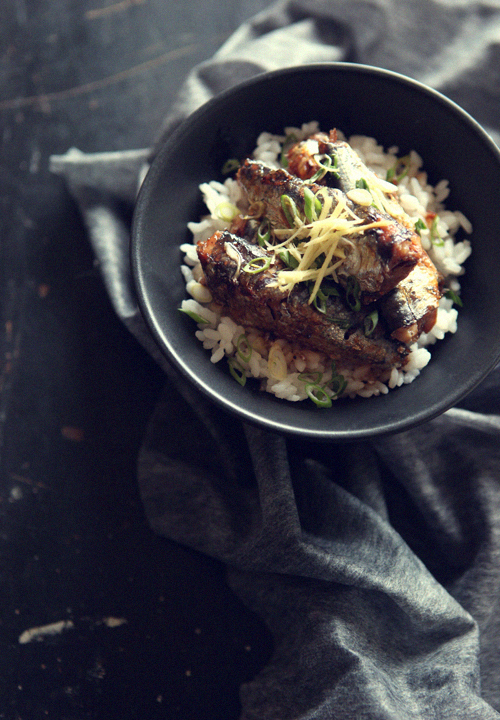
This is a super quick and easy rice bowl dish.
The combination of caramelised sweet soy sauce and sardine is simply delicious.
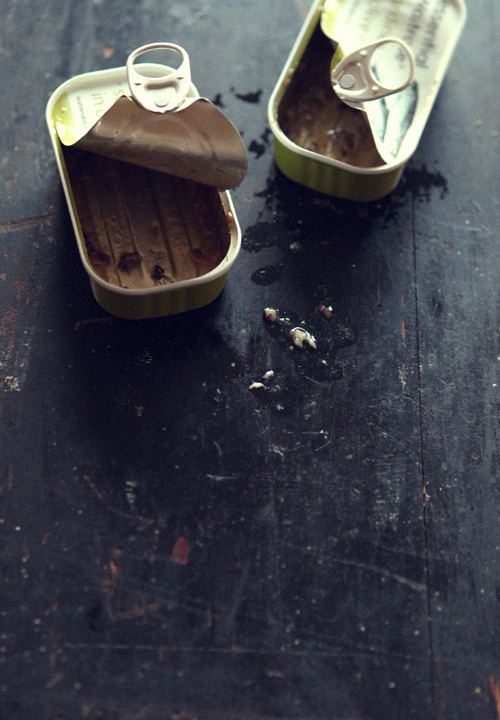
——————————
— Caramelised Soy Sardine Bowl (serves 1)—
1 tablespoon soy sauce
1 tablespoon mirin
1 teaspoon sugar
1 tin sardine in oil, drained
1 serving cooked rice
Spring onion (for garnish), finely chopped
Ginger (for garnish), finely julienned
——————————
Mix the soy sauce, mirin and sugar in a small bowl.
Heat a frying-pan, add the sardines and cook for 1 minutes on both sides over a medium heat.
Pour the sauce in the frying-pan, turning the sardines several times to coat well with the sauce, cook until the sauce became thick.
Place rice in a bowl, top with the sardines, chopped spring onion and ginger.
April 9th, 2014 § § permalink

This simple potato dish has a delicious depth of flavour – sweet, savoury and a little kick of heat.
It’s a unique and addictive side dish.
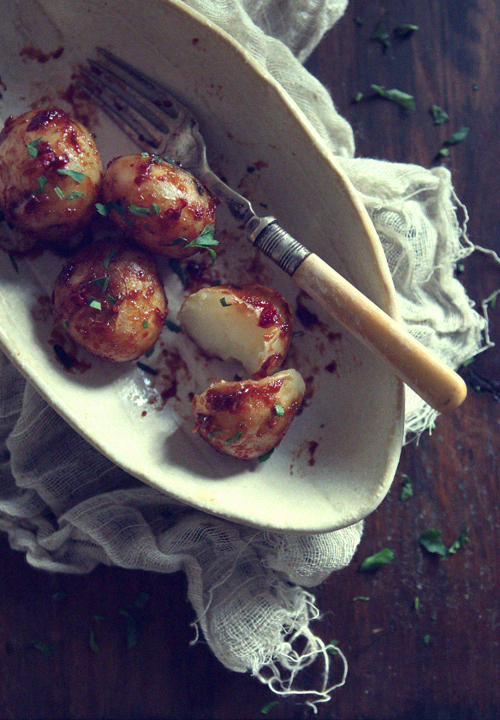
——————————
— Spicy Sweet Miso Glazed Baby Potatoes —
700g baby potatoes
2 tablespoons miso paste (medium-coloured)
1 tablespoon mirin
1 tablespoon sugar
1/4 teaspoon chilli flakes
2 tablespoons sesame oil
Some flat-leaf parsley, chopped
——————————
Boil the potatoes in lightly salted water until just tender, drain and leave to cool slightly.
Combine the miso paste, mirin, sugar and chilli flakes in a small bowl. Set aside.
Heat the sesame oil in a large frying-pan, add the potatoes and fry them over a medium heat until golden brown.
Add the miso sauce, gently stir-fly the potatoes to coat well with the sauce for about 2 minutes until the sauce becomes caramelised.
Serve hot and sprinkle with chopped parsley.
April 3rd, 2014 § § permalink
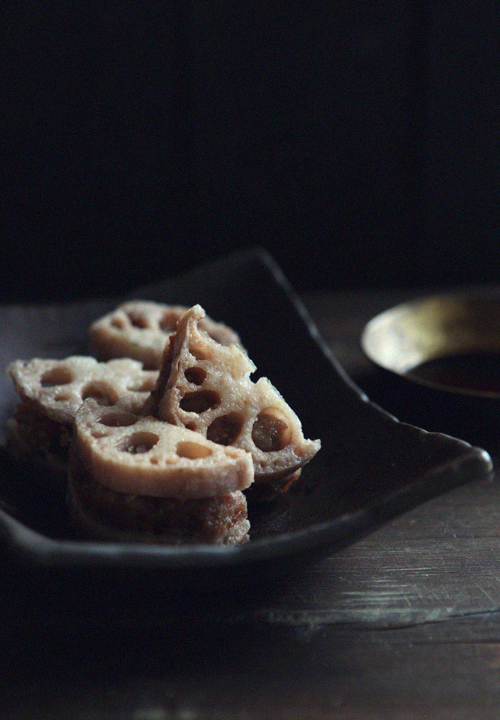
Lotus is not just a beautiful floating flower, the root has been used for centuries as a staple vegetable in East Asian cooking. It has a crunchy texture like water chestnut and a delicate flavour, also it’s rich in important vitamins and minerals.
Deep-fried lotus root sandwich is a typical Japanese home-style dish, my mum often made it when I was a kid and I loved it.
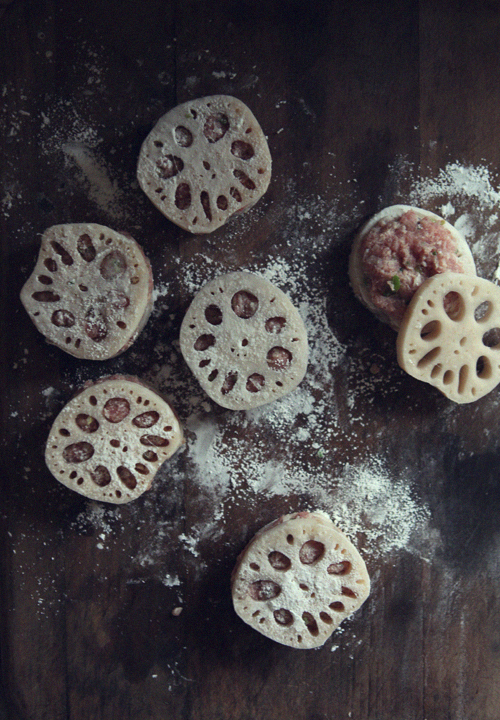
——————————
— Deep-Fried Lotus Root Pork Sandwiches (serves 2-3) —
400g lotus roots
A dash of vinegar
200g minced pork
1 spring onion, finely chopped
1 teaspoon grated ginger
1 teaspoon sake (rice wine)
1 tablespoon cornflour
1/2 teaspoon salt
A pinch of black pepper
Some cornflour for dusting
Vegetable oil for deep frying
Soy sauce for dipping
——————————
Peel and slice the lotus root into 1/4 inch slices and soak them in a large bowl of water with a dash of vinegar for 5 minutes.
Drain the lotus root and pat dry with kitchen paper, lightly dust with cornflour on both sides
Place the pork mince, spring onion, grated ginger, sake, 1 tablespoon of cornflour, salt and pepper in a bowl. Mix well with hands until the mixture becomes sticky.
Place about a tablespoon of the pork mixture on a slice of the routs root and put another slice on top. Press down to make a sandwich.
Heat the oil to 340F/170C. Deep fry them until slightly coloured and cooked through. Place on kitchen paper to drain excess oil.
Serve with soy sauce for dipping.
March 27th, 2014 § § permalink
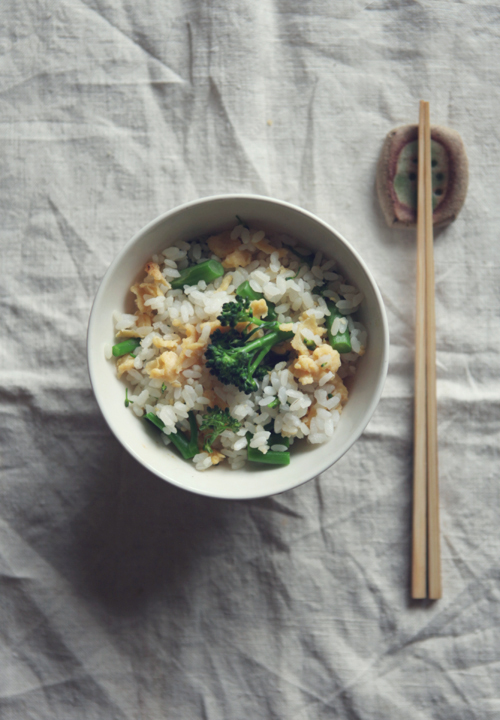
This is a spring dish.
It looks like the yellow flowers of tenderstem broccoli are blooming in a bowl.
I hope spring is coming soon.
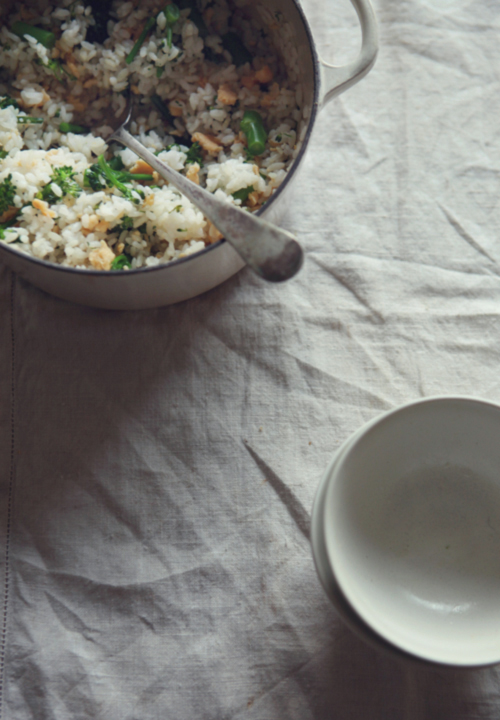
——————————
— Tenderstem Broccoli and Egg Rice (serves 2-3) —
300g rice (Japanese short grain white rice, or sushi rice)
400ml water
2 tablespoons sake (rice wine)
1/2 teaspoon sea salt
10cm square kombu
100g tenderstem broccoli
1 tablespoon light soy sauce
2 eggs
A pinch of salt
——————————
Rinse the rice in a clod water, changing the water several times until the water runs almost clear.
Drain the washed rice in a sieve and place in a saucepan.
Add the water, sake and 1/2 teaspoon of salt in the pan, place the kombu on top of the rice and cover with tight-fitting lid.
Bring to the boil over high heat and let cook for 2 minute. Reduce the heat to the lowest and simmer (always cover the pan with a lid) for 15 minute. Remove from the heat, still covered, and leave the pan for another 10 minutes.
Bring a pot of water to boil and add a pinch of salt. Cook the tenderstem broccoli until soft but still crunchy (about 30 seconds – 1 minute), rinse in cold water, drain and squeeze excess water. Cut the tenderstem broccoli into 0.8 inch, toss with the light soy sauce.
Beat the eggs in a bowl and add a pinch of salt. Heat a frying-pan, pour the eggs and stir continuously until they form finer scrambled eggs.
Add the tenderstem broccoli and scrambled eggs in to the cooked rice, mix everything together gently.
March 8th, 2014 § § permalink
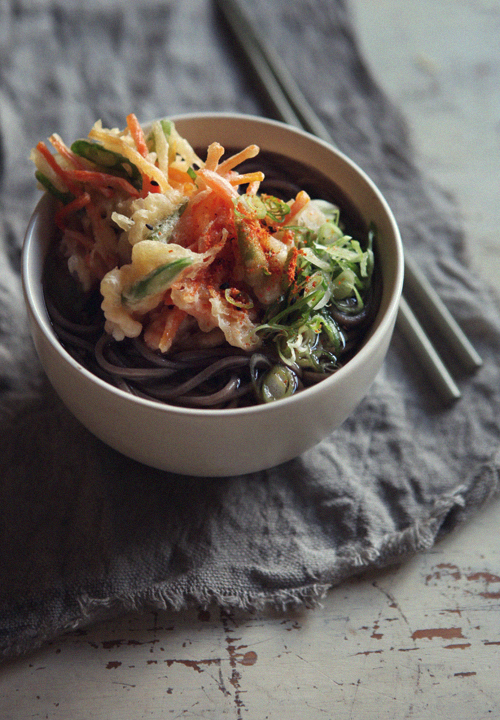
Kakiage is a type of tempura fritter made with mixed vegetable strips, and it’s one of the most popular topping for Japanese soba noodle soup.
I used kombu dashi (dried kelp stock) for this noodle soup, so it’s a good vegan recipe :)
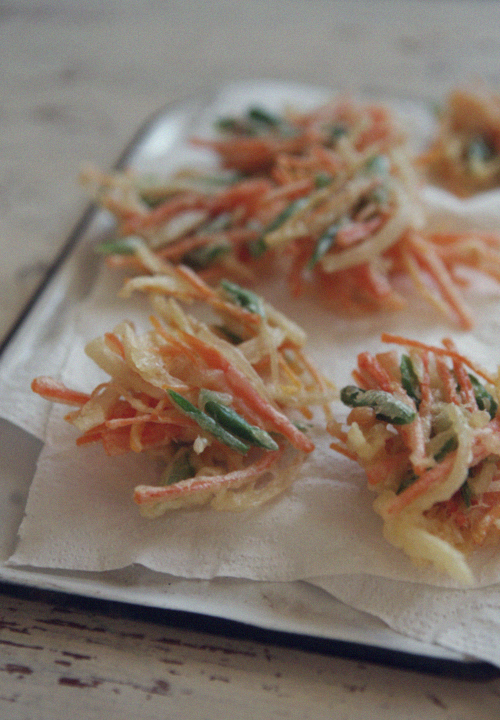
——————————
— Vegetable Kakiage Soba Noodle Soup (serves 4) —
400g soba noodles
Some spring onion, finely chopped
Vegetable oil for deep-frying
Nanami chilli pepper (optional)
*****
— for noodle soup (kombu dashi) —
25g kombu (dried kelp)
1200ml water
80ml soy sauce
80ml mirin (Japanese sweetened rice wine)
*****
— for vegetable kakiage —
90g plain flour
1 teaspoon baking powder
150ml water
2 ice cubes
1 carrot (medium size), julienned
1/2 onion, thinly sliced
80g green beans, chopped
——————————
Cook the soba noodles in a large pot of boiling water until cooked (follow the package directions) and drain.
Place the cooked soba noodles in a deep bowl, pour in the hot noodle soup, arrange the vegetable kakiage on top, garnish with chopped spring onion and sprinkle with nanami chilli pepper (optional).
*****
— to make noodle soup —
Lightly wipe the kombu with a clean damp cloth, Put the kombu in a large saucepan, cover with 1200ml of water and soak for 30 minutes.
Set the saucepan over a medium heat. Just before the water comes to a boil, remove the kombu.
Place the kombu stock, soya sauce and mirin in a pan and bring to the boil, turn down the heat to low and simmer the noodle soup about 2 minutes.
*****
— to make vegetable kakiage —
Heat the oil in a deep pan to 170C/340F.
Combine the flout and baking powder in a bowl.
Place 150ml water and 2 ice cubes in another bowl, add the flour mixture and mix together very lightly.
Add the carrot, onion and green beans in the batter and mix together.
Take a scoop of the mixture with a large spoon and slip into the oil. Shape the piece, deep-fry until crisp and golden.
Drain excess oil on kitchen paper.
February 14th, 2014 § § permalink
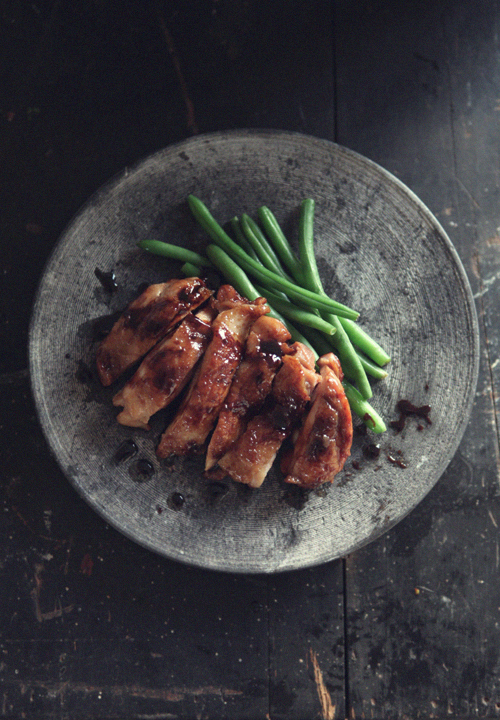
“Teriyaki” is probably the most popular and well-known Japanese sauce.
This delicious sweet and savoury sauce goes especially well with chicken, salmon and tofu.
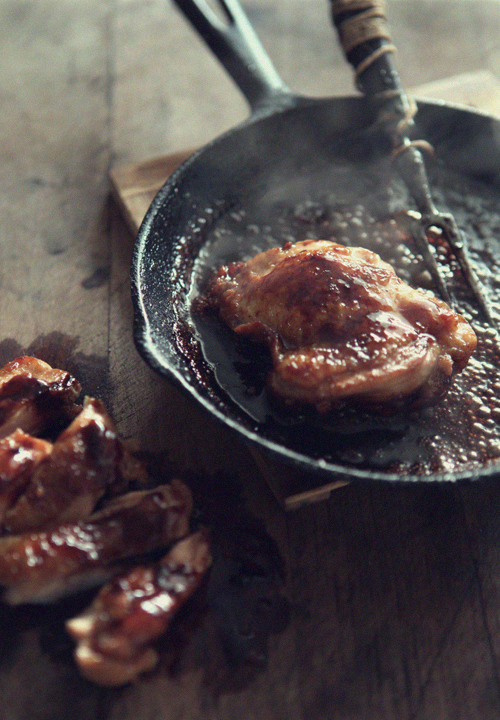
——————————
— Chicken Teriyaki (serves 2) —
3 tablespoons Japanese soy sauce
3 tablespoons mirin (Japanese sweetened rice wine)
3 tablespoons sake (rice wine)
2 tablespoons sugar
2 large chicken thighs (or 4 small chicken thighs), skin-on, boneless
1 tablespoon vegetable oil
——————————
Combine the soy sauce, mirin, sake and sugar in a bowl.
Heat the oil in a frying-pan, lay the chicken, skin side down, and fry over a medium heat until skin is browned. Turn the chicken and cover the frying-pan and steam cook the chicken over a low heat until cooked through.
Pour the sauce in the frying-pan, turning the chicken several times to coat well with the sauce, cook until the sauce became thick.
Cut the chicken crosswise into 3/4 inch slices. Serve hot.
February 4th, 2014 § § permalink
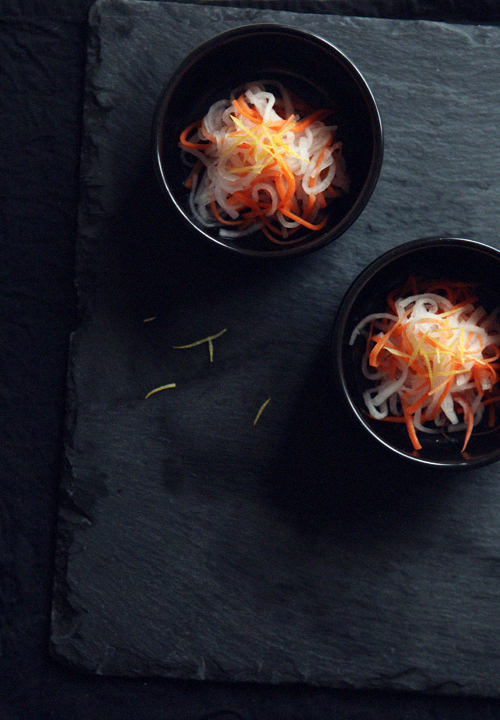
This is a traditional Japanese dish and it’s called “Kōhaku Namasu”. “Kōhaku” means “red and white”, this combination of colour is a symbol for auspicious or happy occasions in Japan, and Kōhaku Namasu is one of the festive food for the New Year.
White daikon radish and red (actually it’s orange…) carrot are lightly pickled in sweetened vinegar. It’s a light and refreshing side dish.
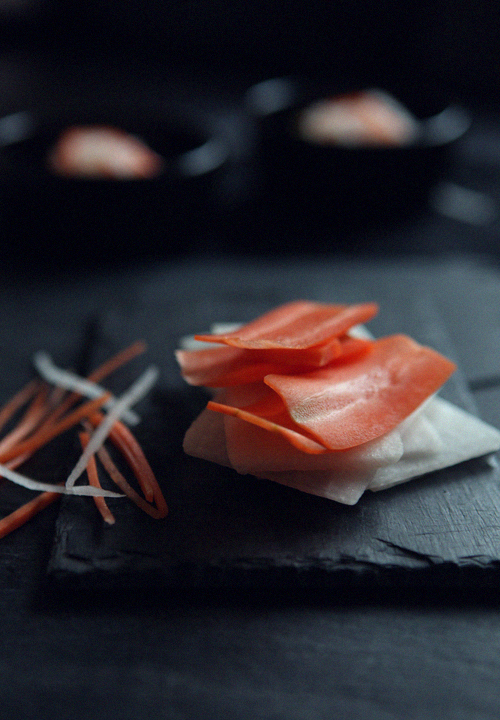
——————————
— Rickled Radish and Carrot Salad (serves 4) —
400g daikon (mooli) radish
80g carrot
1 teaspoon salt
5 tablespoon rice vinegar
4 tablespoon caster sugar
A small piece of yuzu citrus or lemon peel, very finely julienned
——————————
Peel the radish and carrot and cut into about 2 inch long thin strips.
Place in a bowl, sprinkle with the salt, mix and leave for about 15 minutes. Squeeze well to remove excess water.
Combine the rice vinegar and sugar in a small bowl.
Pour the vinegar mixture over the radish and carrot and mix well. Cover and place in the fridge for few hours.
Just before serving, garnish each portion with julienned yuzu or loon peel.
January 26th, 2014 § § permalink
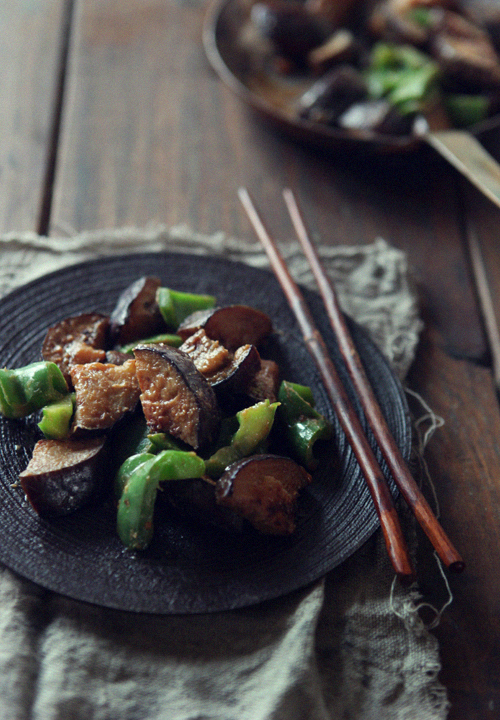
This is a Japanese home-style dish. Sweet and savoury miso sauce gives the vegetables a very rich and appetising flavour. Serve with steamed plain rice.
Miso is fermented soya bean paste, made from soya beans and normally rice or barley are mixed with salt and koji (a formentation starter) and allow to ferment for six months to five years.
It comes in many colours, creamy white, yellow, red brown and dark brown, etc.
Usually the light coloured miso has light flavour and dark coloured miso has strong flavour.
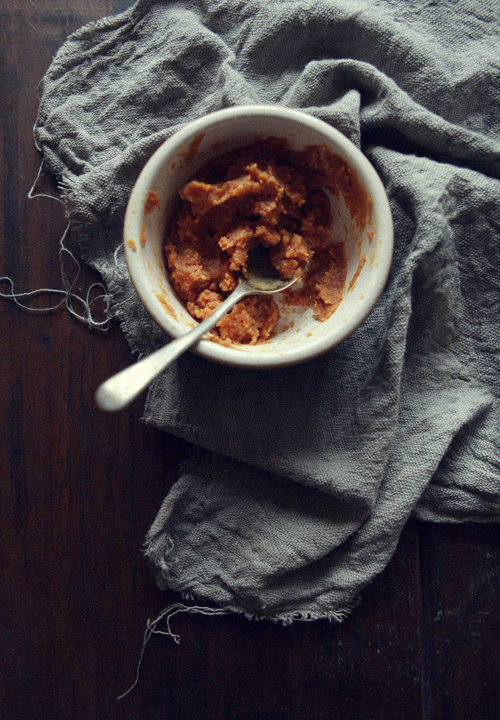
——————————
— Sweet Miso Stir-Fried Aubergine & Green Pepper (serves 2) —
1 aubergine
1/2 green pepper
1 tablespoon miso paste (mideum-coloured)
1 tablespoon sake (rice wine)
1/2 tablespoon sugar
1/2 tablespoon soy sauce
3 tablespoons sesame oil
——————————
Cut the aubergine into bite-sized pieces, immerse in water for 10 minutes and drain.
Cut the green pepper into bite-sized pieces.
Mix the miso paste, sake, sugar and soy sauce in a small bowl.
Heat the sesame oil in a frying-pan. Fry the aubergine over a low-medium heat until softened. Add the green peppers and fir-fry for 4-5 minutes.
Add the miso sauce and stir-fry until the liquid is evaporated.
January 22nd, 2014 § § permalink
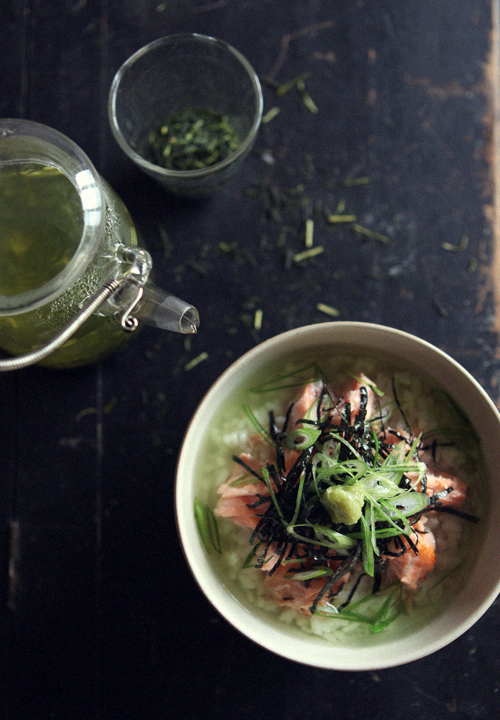
Ochazuke is a simple and easy Japanese dish. Pouring hot tea over cooked rice, roughly in the same proportion as milk over cereal, and topped with savoury toppings. It’s popular as a light meal or after-drinking snack in Japan.
In the olden days in Kyoto, when a host asks if you want to eat ochazuke, it means you have overstayed their welcome and it being politely asked to leave.
But don’t worry, it’s the custom of the past. If you are offered ochazuke in Kyoto now, then just enjoy :)
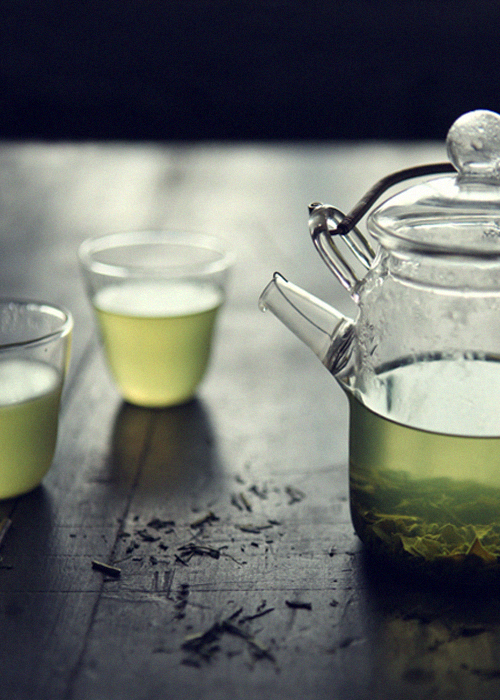
——————————
— Salmon Ochazuke (serves 2) —
1 piece salmon fillet
Sea salt
1 tablespoon vegetable oil
1 cup cooked short grain white rice
2 cups Japanese green tea
1/2 sheet nori, finely shredded with kitchen scissors
1/2 spring onion, finely sliced
Wasabi paste
——————————
Rub the salmon fillet with a generous amount of sea salt.
Heat the vegetable oil in a frying-pan, cook the salmon on both sides over a medium heat until cooked through. Break the salmon into chunks.
Place the cooked rice in a bow, top with the salmon, nori, spring onion and a little wasabi paste.
Pour hot green tea over the rice.
February 1st, 2013 § § permalink
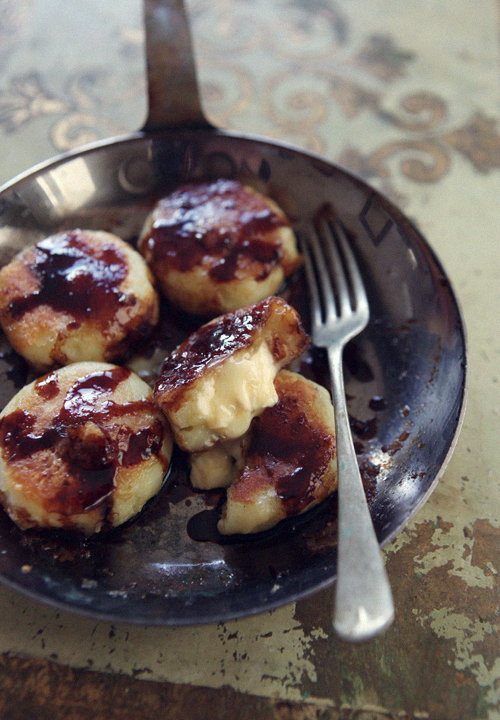
This is a regional snack of my hometown Hokkaido.
The combination of butter and soy sauce is very popular in Japan, it works perfectly well with this potato cakes.
Hokkaido must be covered with snow as far as the eye could see now.
Everything is white. I miss the scenery.

——————————
— Camembert Cheese Potato Cakes (makes 12 cakes) —
500g potatoes, peeled and cut into chunks
80g corn flour
1/3 teaspoon salt
100g camembert cheese, cut into 12 pieces
30g butter
2 tablespoons soy sauce
1 tablespoon sugar
——————————
Cook the potatoes in lightly salted boiling water for 10 minutes, until tender. Drain and mash. Add the the corn flour and salt, mix everything together well with your hands.
Divide the potato mixture into 12 portions, take one portion in your hand, press a piece of camembert cheese into middle. Shape the potato cake into a cake.
Heat the butrter in a large frying pan over a medium heat. Fry the potato cakes for about 5 minutes each side or until they are golden, crisp and heated through.
Heat the soy sauce and sugar in a small sauce pan over a medium heat, stirring constantly until the sauce is thickens and syrupy. Drizzle the sauce over the potato cakes.



















